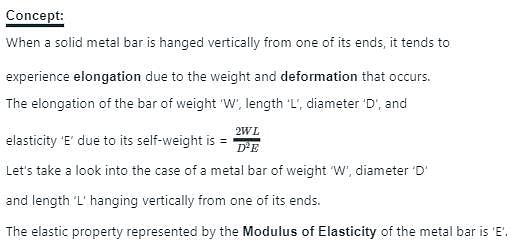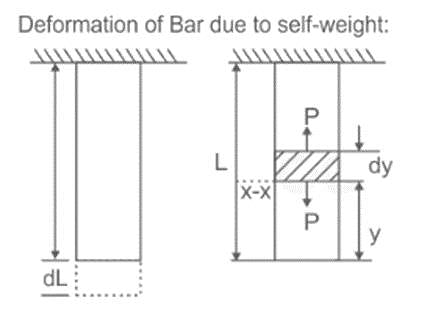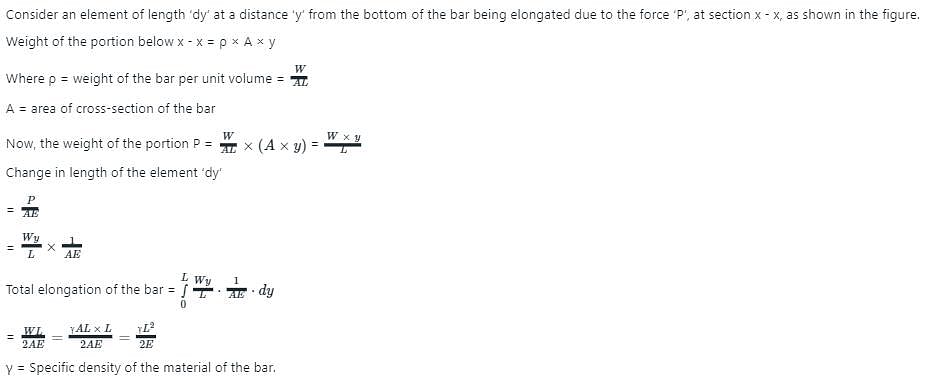Civil Engineering (CE) Exam > Civil Engineering (CE) Questions > A solid uniform metal bar of diameter D and l...
Start Learning for Free
A solid uniform metal bar of diameter D and length L is hanging vertically from its upper end.The elongation of the bar due to self weight is
- a)Proportional to L2 and inversely proportional to D2
- b)Proportional to L2 but independent of D
- c)Proportional to L but independent of D
- d)Proportional to L and inversely proportional to D2
Correct answer is option 'B'. Can you explain this answer?
Verified Answer
A solid uniform metal bar of diameter D and length L is hanging vertic...



Most Upvoted Answer
A solid uniform metal bar of diameter D and length L is hanging vertic...



Free Test
FREE
| Start Free Test |
Community Answer
A solid uniform metal bar of diameter D and length L is hanging vertic...
Explanation:
When a uniform metal bar of diameter D and length L is hanging vertically from its upper end, the weight of the bar causes it to elongate due to self-weight. The elongation of the bar can be calculated using the following formula:
δ = (4MgL)/(πD^2E)
where δ is the elongation, M is the mass of the bar, g is the acceleration due to gravity, E is the Young's modulus of elasticity of the material, and π is the mathematical constant pi.
Proportional to L and inversely proportional to D^2:
From the above formula, we can see that the elongation of the bar is directly proportional to the length L of the bar and inversely proportional to the square of the diameter D. This means that if we double the length of the bar, the elongation will also double, but if we double the diameter of the bar, the elongation will be reduced to one-fourth of its original value.
Independent of D:
However, we cannot say that the elongation is independent of D, as the formula clearly shows the dependence of elongation on D. Therefore, option 'C' and 'D' are incorrect.
Conclusion:
Hence, the correct answer is option 'B', which states that the elongation of the bar is proportional to L and inversely proportional to D^2.
When a uniform metal bar of diameter D and length L is hanging vertically from its upper end, the weight of the bar causes it to elongate due to self-weight. The elongation of the bar can be calculated using the following formula:
δ = (4MgL)/(πD^2E)
where δ is the elongation, M is the mass of the bar, g is the acceleration due to gravity, E is the Young's modulus of elasticity of the material, and π is the mathematical constant pi.
Proportional to L and inversely proportional to D^2:
From the above formula, we can see that the elongation of the bar is directly proportional to the length L of the bar and inversely proportional to the square of the diameter D. This means that if we double the length of the bar, the elongation will also double, but if we double the diameter of the bar, the elongation will be reduced to one-fourth of its original value.
Independent of D:
However, we cannot say that the elongation is independent of D, as the formula clearly shows the dependence of elongation on D. Therefore, option 'C' and 'D' are incorrect.
Conclusion:
Hence, the correct answer is option 'B', which states that the elongation of the bar is proportional to L and inversely proportional to D^2.

|
Explore Courses for Civil Engineering (CE) exam
|

|
Similar Civil Engineering (CE) Doubts
A solid uniform metal bar of diameter D and length L is hanging vertically from its upper end.The elongation of the bar due to self weight isa)Proportional to L2 and inversely proportional to D2b)Proportional to L2but independent of Dc)Proportional to L but independent of Dd)Proportional to L and inversely proportional to D2Correct answer is option 'B'. Can you explain this answer?
Question Description
A solid uniform metal bar of diameter D and length L is hanging vertically from its upper end.The elongation of the bar due to self weight isa)Proportional to L2 and inversely proportional to D2b)Proportional to L2but independent of Dc)Proportional to L but independent of Dd)Proportional to L and inversely proportional to D2Correct answer is option 'B'. Can you explain this answer? for Civil Engineering (CE) 2025 is part of Civil Engineering (CE) preparation. The Question and answers have been prepared according to the Civil Engineering (CE) exam syllabus. Information about A solid uniform metal bar of diameter D and length L is hanging vertically from its upper end.The elongation of the bar due to self weight isa)Proportional to L2 and inversely proportional to D2b)Proportional to L2but independent of Dc)Proportional to L but independent of Dd)Proportional to L and inversely proportional to D2Correct answer is option 'B'. Can you explain this answer? covers all topics & solutions for Civil Engineering (CE) 2025 Exam. Find important definitions, questions, meanings, examples, exercises and tests below for A solid uniform metal bar of diameter D and length L is hanging vertically from its upper end.The elongation of the bar due to self weight isa)Proportional to L2 and inversely proportional to D2b)Proportional to L2but independent of Dc)Proportional to L but independent of Dd)Proportional to L and inversely proportional to D2Correct answer is option 'B'. Can you explain this answer?.
A solid uniform metal bar of diameter D and length L is hanging vertically from its upper end.The elongation of the bar due to self weight isa)Proportional to L2 and inversely proportional to D2b)Proportional to L2but independent of Dc)Proportional to L but independent of Dd)Proportional to L and inversely proportional to D2Correct answer is option 'B'. Can you explain this answer? for Civil Engineering (CE) 2025 is part of Civil Engineering (CE) preparation. The Question and answers have been prepared according to the Civil Engineering (CE) exam syllabus. Information about A solid uniform metal bar of diameter D and length L is hanging vertically from its upper end.The elongation of the bar due to self weight isa)Proportional to L2 and inversely proportional to D2b)Proportional to L2but independent of Dc)Proportional to L but independent of Dd)Proportional to L and inversely proportional to D2Correct answer is option 'B'. Can you explain this answer? covers all topics & solutions for Civil Engineering (CE) 2025 Exam. Find important definitions, questions, meanings, examples, exercises and tests below for A solid uniform metal bar of diameter D and length L is hanging vertically from its upper end.The elongation of the bar due to self weight isa)Proportional to L2 and inversely proportional to D2b)Proportional to L2but independent of Dc)Proportional to L but independent of Dd)Proportional to L and inversely proportional to D2Correct answer is option 'B'. Can you explain this answer?.
Solutions for A solid uniform metal bar of diameter D and length L is hanging vertically from its upper end.The elongation of the bar due to self weight isa)Proportional to L2 and inversely proportional to D2b)Proportional to L2but independent of Dc)Proportional to L but independent of Dd)Proportional to L and inversely proportional to D2Correct answer is option 'B'. Can you explain this answer? in English & in Hindi are available as part of our courses for Civil Engineering (CE).
Download more important topics, notes, lectures and mock test series for Civil Engineering (CE) Exam by signing up for free.
Here you can find the meaning of A solid uniform metal bar of diameter D and length L is hanging vertically from its upper end.The elongation of the bar due to self weight isa)Proportional to L2 and inversely proportional to D2b)Proportional to L2but independent of Dc)Proportional to L but independent of Dd)Proportional to L and inversely proportional to D2Correct answer is option 'B'. Can you explain this answer? defined & explained in the simplest way possible. Besides giving the explanation of
A solid uniform metal bar of diameter D and length L is hanging vertically from its upper end.The elongation of the bar due to self weight isa)Proportional to L2 and inversely proportional to D2b)Proportional to L2but independent of Dc)Proportional to L but independent of Dd)Proportional to L and inversely proportional to D2Correct answer is option 'B'. Can you explain this answer?, a detailed solution for A solid uniform metal bar of diameter D and length L is hanging vertically from its upper end.The elongation of the bar due to self weight isa)Proportional to L2 and inversely proportional to D2b)Proportional to L2but independent of Dc)Proportional to L but independent of Dd)Proportional to L and inversely proportional to D2Correct answer is option 'B'. Can you explain this answer? has been provided alongside types of A solid uniform metal bar of diameter D and length L is hanging vertically from its upper end.The elongation of the bar due to self weight isa)Proportional to L2 and inversely proportional to D2b)Proportional to L2but independent of Dc)Proportional to L but independent of Dd)Proportional to L and inversely proportional to D2Correct answer is option 'B'. Can you explain this answer? theory, EduRev gives you an
ample number of questions to practice A solid uniform metal bar of diameter D and length L is hanging vertically from its upper end.The elongation of the bar due to self weight isa)Proportional to L2 and inversely proportional to D2b)Proportional to L2but independent of Dc)Proportional to L but independent of Dd)Proportional to L and inversely proportional to D2Correct answer is option 'B'. Can you explain this answer? tests, examples and also practice Civil Engineering (CE) tests.

|
Explore Courses for Civil Engineering (CE) exam
|

|
Signup for Free!
Signup to see your scores go up within 7 days! Learn & Practice with 1000+ FREE Notes, Videos & Tests.


























